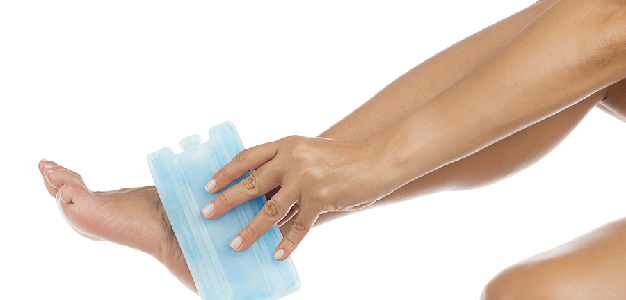When anyone has a sprain, strain or nasty bruise, I remind them about the standard RICE treatment — rest, ice, compression, elevation. It’s what every first aid course teaches and every medical source recommends. But is it the best option?
When you injure yourself it hurts and swells up as the body floods the area with immune cells that will orchestrate the healing.
For decades we’ve used ice to reduce this inflammation. But now it’s argued that it’s a good thing; it’s the first stage of repair, and if we limit it with our pack of frozen peas we’re slowing down our recovery.
Researchers who’ve compared ice treatment to doing nothing say that ahem, ice doesn’t help.
It does help with pain, but it seems that if we can put up with the way the injury feels and let nature bring on the inflammation, it’ll take care of the healing.
And compression and elevation? Since they’re also designed to reduce swelling, research isn’t giving them a thumbs-up either.
So, what should you do if you twist an ankle, strain your back or bruise yourself?
I think it’s important not to throw the baby out with the bathwater just yet.
The best response could depend on the type of injury and its severity. This also mightn’t be a one-size-fits-all issue. In the sports world, some athletes swear by ice baths for their recovery while others believe in heat.
And perhaps the RICE method worked for placebo reasons. If ice, compression and so on made us feel better, maybe that helped us to heal.
If I had a bad ankle sprain I’d probably still use RICE for the first few days. Mobility is important for ankles, so I wouldn’t want to risk it being stiff and sore six weeks down the track. I’d also be trying to gently move it as soon as the pain would let me.
By that I mean circling it, pointing and flexing, and trying to trace the alphabet with my toes to take the joint through lots of direction changes.
I’d be trying to walk as soon as I reasonably could, without overdoing it. When it was feasible, I’d start some calf raises (lifting the heels off the ground and back again) and build up to one-legged balance.
I’d want to make sure I got that ankle strong enough that it wasn’t going to be vulnerable in future.
With the back strain I’d now be inclined to try gently warming the area and taking it easy for a few days.
NSAIDS (non-steroidal anti-inflammatory drugs, such as Nurofen and Voltaren) are typically used to reduce pain and inflammation, so do they also suppress the natural healing process?
Maybe. But like ice they can help us to restore normal function too.
NSAIDS have problematic side-effects though and need to be used in short doses. Instead of those I’d keep some Traumeel on hand.
It’s a German product sold in cream or tablet form and it’s been shown to be as effective as NSAIDS without the side-effects. It’s made from plant and mineral extracts and has been used in Europe for decades.
Cream or tablets? I’d use both, but that’s me.
I’d use it for all three injuries — for a strain, after the acute stage of an ankle sprain, and for bruises (I’d also use ice on a bad bruise). Traumeel’s also useful for tendinitis, arthritic pain or fibromyalgia.
That’s my take at this stage. But there are other options. For example, some people find acupuncture helps to stimulate healing.
As we get older we can be more prone to niggly injuries. It pays to consider what the research is saying, but also what’s worked for you in the past. And be prepared.
Photo source: Bigstock

